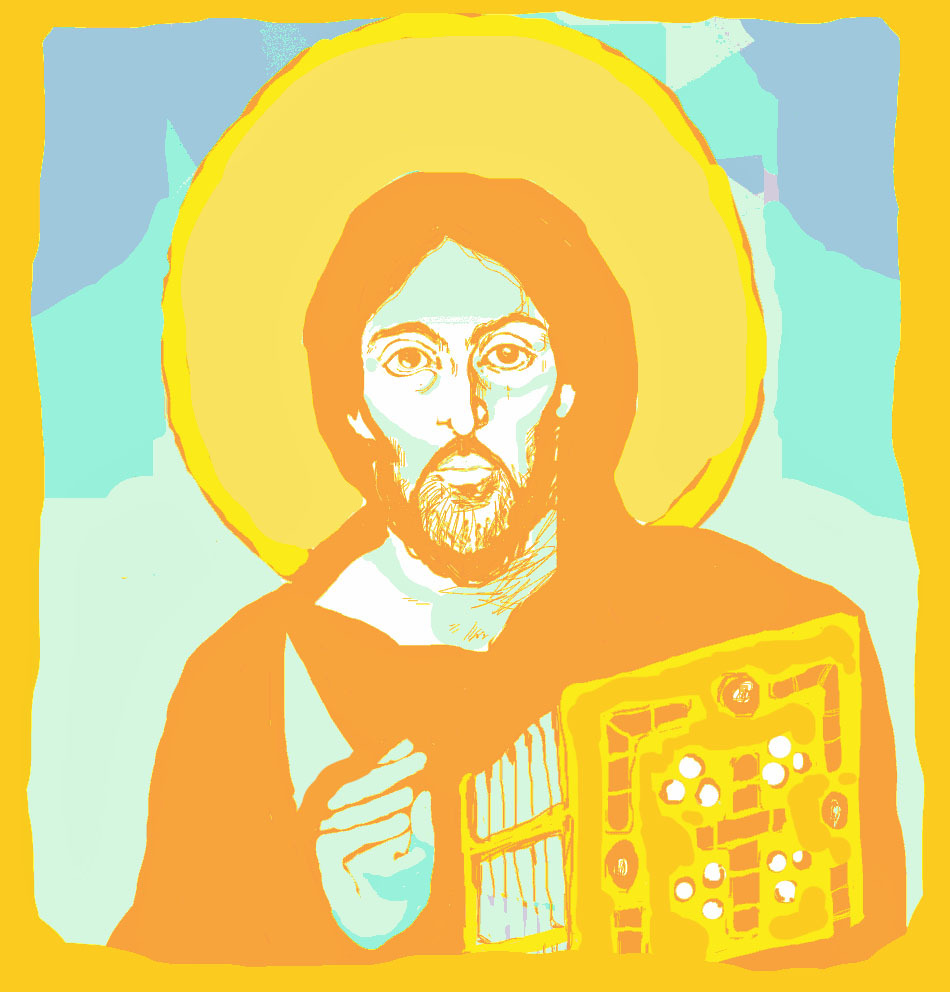

Art by Mary Palumbo
Transparency Item: The Perspectives section of the Graphic is comprised of articles based on opinion. This is the opinion and perspective of the writer.
Icons are a form of worship that artfully display holy and sacred beings. Icons are more than works of art. They teach us things. They live and breathe, instilling wisdom from Christianity through the aesthetic medium.
The definition of an Icon is vague and shadowy. I never really understood how an image or piece of art could teach and nurture faith. An injury over the summer taught me how Icons emanate wisdom.
I came across the Icon of Christ Pantocrator at Sinai while reading Pepperdine’s Professor of Great Books Paul J. Contino’s excellent book on Dostoevsky and Incarnational realism. In this Icon, the two faces of Christ split down the middle, the left exhorting and reproachful and the right pitying and loving. At first, the lack of symmetry between the left and right sides of Christ’s lovingly-portrayed face may seem off-putting, but deeper analysis shows the reason behind this asymmetry.
The right half of Christ’s face is mournful. His right eye locks onto the viewer with compassion and pity. The shadows are less prominent, and his features are less harsh; a white glow of health and plush innocence imbue his face.
On the right side, he calls people to follow Him. There is calm and tranquillity in the right side of his face, drawing in the feeling of the warm glow of home. The right side of Christ’s face almost sighs like a disappointed father, looking in pity at his child, who insists on touching the hot stove and burning himself. Christ seems to say, “Come here, poor child; I’ll take care of you.”
The left side of the face, however, is much less sanguine. Christ’s stare pierces directly into the viewer. The darker shadows around his cheekbones and eyes, combined with the angular and arched eyebrows, make the right side of Christ’s face seem almost alien and inhuman, emphasizing humanity’s painful separation from God.
Christ’s left pupil centers in his iris, as opposed to the right side of his face, which is looking up, appealing to a higher nature. Christ’s harsh expression encapsulates the difference between a look and a stare. Christ intently stares at the viewer, making one feel as if they have been judged and found wanting.
This icon symbolizes two symbiotic approaches in Christianity. The right side of Christ’s face acknowledges the capacity for good inherent in all humanity. The left side of Christ’s face focuses on sin and separation from God, reproaching humanity for evil. These two halves are held in a transcending golden mean only in Christ.
One of the fundamental tenets of Christianity is that man is made in the image of God. This feature allows humanity to be similar and unique at the same time. I face challenges that are uniquely mine, yet somehow, others can relate to them. I learned which half of Christ I lacked through my injury.
I tore my knee ligaments kickboxing. After hearing the ungodly sound of my knee popping and cracking like a can of soda, I still insisted on boxing without kicks and continued to train for two hours afterward.
Being the fool I was, I didn’t realize that adrenaline was serving to numb my knee’s pain while I continued tearing it apart. The reality became apparent when I woke up unable to walk, and my knee had swollen up like a balloon.
During this period of rest and recovery, I became bitter and resentful, hating myself for being unable to walk.
I started trying to push my luck, deciding to force myself to get better, exercising in any small way I could to fix my knee. Ignoring my doctor’s advice, I did squats and single-leg deadlifts, prolonging my injury. Sometimes the hardest thing in the world is to do nothing.
Only a month into this unhealthy cycle of self-reproach, I remembered the right half of Christ’s face — full of understanding, pity and love — and I felt calm. It wasn’t as if all my problems had disappeared, but I began to see how my self-reproach was hurting me. I had to see myself in the eyes of compassionate Christ to see my value and potential as a child of God.
Once I had stopped being so hard on myself and let my knee heal, I saw an exponential increase in recovery. It’s been two months since my injury, and I’m glad to say I am back at the squat rack.
Rest and recovery, whether physical or psychological, is extremely hard for me and, I suspect, for other individuals who are more negatively driven. During recovery, I may think I am doing nothing, but, in reality, I am ever-present and always active in whatever I do.
Doing nothing is still, paradoxically, something I inevitably choose to do. The Icon of Christ Pantocrator has shown me that even rest can be a struggle, but it is a struggle I must acknowledge.
________________________________________________
Follow the Graphic on Twitter: @PeppGraphic
Contact Arik Chu via email: arik.chu@pepperdine.edu or by Instagram @arik_chu

